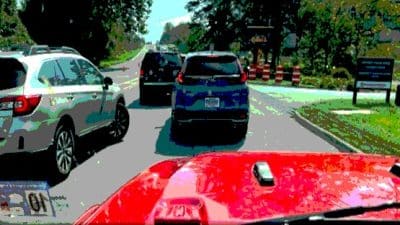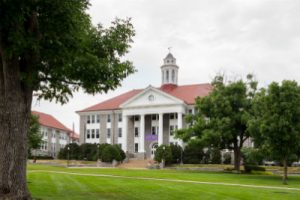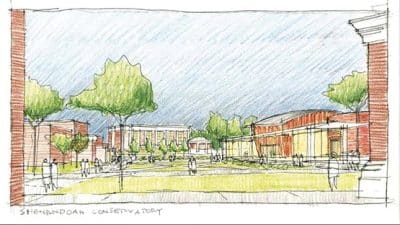
Springtime visitors can expect to stroll by asparagus hedges on their way to the tennis courts. They’ll circumvent the compost pile and chicken house-on-wheels by the soccer field. And they’ll need to avoid disturbing the four beehives near a popular hilltop meeting room.
Situated on the western edge of the small city of Harrisonburg, Va. – often overshadowed by nearby James Madison University with 10 times the student population – EMU is gradually gaining a small measure of fame for its devotion to what it calls “creation care.”
“Caring for God’s creation” started in 1976-77 at EMU when a science professor opted to spend his sabbatical year studying the ways the college could cut fuel consumption. He succeeded. Among other steps, EMU launched into energy-efficient construction, with new buildings heated and cooled by a unique closed-loop system in the 1980s. In the fall of 2010 EMU became the host of what was then the largest solar-panel deployment in Virginia.
In 2011, students and grounds workers created an “edible landscape” by sprinkling 1,000 food-producing plants around the 100-acre campus.
“This started because students saw ‘Food Inc.’ [a 2008 documentary, critiquing agribusiness] and began knocking on my door saying, ‘Hey, we want to grow food on campus,’” said Will Hairston, grounds supervisor at EMU.
The students found receptive ears – Hairston has a degree in horticulture from Virginia Tech. Yet, in his 20 years at EMU, Hairston had mainly focused on planting ornamentals, believing their beauty to be “food for the soul.”
Suddenly Hairston found himself running to keep “just a half step ahead of the students,” who were pointing out the beauty of lettuce and acorn squash and persimmon trees.
Students, joined by a handful of faculty members, began raising vegetables in three large garden areas on campus. They now sell their produce, when in season, on Saturday mornings near the University Commons. They also give the campus community the option of harvesting their own produce, asking only that harvesters contribute back by weeding or otherwise helping out.
Apple and pear saplings now dot the western hill that backs EMU. “Pruning the trees has been my baby,” said senior Alyshia Zimmerman. She also helped set up the beehives, donated by seminary professor Kenton Derstine, who is mentoring Zimmerman in bee care.
Zimmerman, who is plotting EMU’s edible plants on a master map, pointed to other locations of fruit-bearing trees on campus – fig, plum, persimmon, paw paw, and hazelnut trees can be found near sports fields. Alert campus strollers will spot grape vines and bushes bearing cornelian cherries and raspberries. “We want to raise awareness to the availability and health benefits that these plants can provide,” she said.
Students walking to the quad of “green dorms” – built to LEED “gold” standards, with dual-flush, low-flow toilets, recycled bricks, solar panels that preheat water, and so forth – pass asparagus plants that look yummy but shouldn’t be harvested until year two or later.
In June 2012, a new 100,000-gallon cistern began collecting the runoff from the buildings, roads and parking lots covering 15 acres at EMU. It is now used for watering the grass on four sports fields and other vegetation, including the edible landscaping.
Chickens lay eggs in enclosures behind the science building, not far from a compost heap where the leftovers from the main dining hall eventually turn into soil to nourish the campus vegetable and herb gardens. Much of the produce in these gardens returns to the serving lines of the dining room. The campus chef steps outside her industrial kitchen to pluck basil, cilantro, dill, oregano, parsley, rosemary, thyme and sage.
“Actually being ‘green’ and living in environmentally sustainable ways feels to many of us like returning to the frugality and healthy farming practices of our forebears,” says EMU President Loren Swartzendruber, who was raised in the Mennonite-thick farm community of Kalona, Iowa.
In September 2012, Swartzendruber began a three-year term on the board of directors of the Evangelical Environmental Network, whose mission is “to equip, inspire, disciple and mobilize God’s people in their effort to care for God’s creation.”
This is a group that does not question the view of the majority of the world’s scientists that climate change is occurring and that, left unchecked, will have serious consequences for all forms of life as we know it.
“By tradition and current practice, EMU aims to make decisions that are right in the long term,” says Swartzendruber. “We can’t always see the immediate pay-offs, but we feel we are stewards of the environment in which we all live. The benefits of making the right decisions may accrue to others, or to our descendants, but they are benefits nonetheless.”
The cistern at EMU, for instance, may reduce the amount EMU pays for using city water by up to $4,000 annually. But considering that the cost of the project is nearly $200,000 (with about half the cost covered by a grant from the National Fish and Wildlife Federation’s Chesapeake Bay Stewardship Fund), EMU didn’t build the cistern to save money in the short term.
It was built it in part to enhance the health of the trees and stream in a small park owned by the university. The stream connects with waterways that flow into the Chesapeake Bay. So protecting the feeder stream ultimately contributes to the health of the Bay.
Back to being a campus visitor. . . Here’s a hint at the subtle differences you might notice. Let’s just say a rickshaw driver from India would look at home on this campus – not too different from the EMU employee with muscular calves pedaling a bike hitched to a long cart bearing storage containers. This is the way the recycling bins around campus are serviced. No fossil fuels.
No, no, these Mennonites do not drive horse-drawn buggies. They are modern Mennonites. In fact, half of the campus community isn’t Mennonite at all. But everyone here tends to walk a lot and ride bikes – not because they don’t have drivers’ licenses, but because they believe it is good for the environment and their personal health.
As an example, the undergraduate academic dean – who has close-cropped hair and often wears slacks – hasn’t driven the one-and-a-half miles from her home to campus in four years. She walks, bikes, or takes public transportation.
Sure, if you look closely, you can find a woman who sticks to below-the-knee skirts and who wears a prayer cover on her hair. But look more closely, and you’ll see that this woman is the 76-year-old historical librarian who logged nearly 400 miles on her recreational bike between May and September. And who loves to backpack in Shenandoah National Park.
This campus community doesn’t lend itself to stereotypes. But it does lend itself to great eating.
Article by Bonnie Price Lofton. Photo by Cody Troyer.










